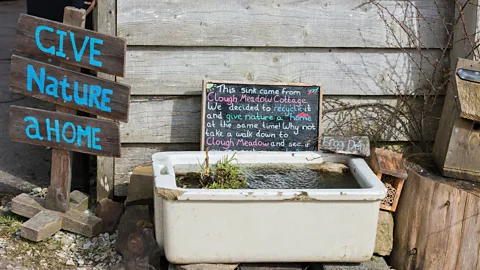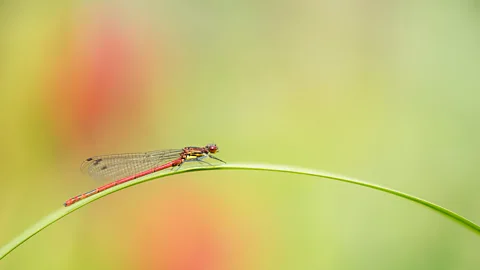Mini ponds are 'tiny universes' of biodiversity for gardens and windowsills
 Heather Stuckey
Heather StuckeyWhen the BBC's Katherine Latham made a pond with just a plant pot, some rocks and a few native pond plants, she was amazed at the speed wildlife moved in.
"I hope we get frogs and newts, and animals of all kinds," said my son, 11-year-old Billy, as we carefully prized apart the roots of a pond plant we were trying to split into three, before plopping them into the water.
It was a sunny Sunday at the beginning of March, in my back garden in Gloucestershire, UK, and my children and I were making three mini ponds. We'd taken three cheap plastic plant pots and dug two of them into the ground, and stood the third surrounded by plants. When then lined them with rocks and filled them with water, rocks and native pond plants.
We were hopeful wildlife would come but, at the same time, apprehensive that – in the midst of a biodiversity crisis – nothing would find its way to our little oases. Then, just one week later, we noticed spiders and insects had begun to visit. Ants were crawling about the edge. Hover flies, bumblebees and ladybirds flittered nearby.
 Ben Andrew
Ben Andrew"Ponds are absolute biodiversity hotspots – in of both the range and density of species that use them. After you fill a hole in the garden with water, wildlife will come – very, very quickly. It's astonishing how quickly it comes," says Adrian Thomas, an expert on gardening for wildlife at the Royal Society for the Protection of Birds and author of book Gardening for Wildlife.
Ponds, he says, offer a mix of habitat types. "Within a pond you have cool bits, open water, shallow bits, the margins around the outside. You get this ecological principle known as the edge effect, where different habitats butt up against each other. It might be easy to think that you've got just two habitats – pond and not pond – but actually, you've got all these interlocking microhabitats." The result, he says, is a "diversity of life that so is much greater than in any other part of the garden".
Species to look out for could include the common frog, smooth newt, water beetles, diving beetles, dragonfly nymphs and caddisfly larvae. Not to mention birds and bats. However, for the amphibians particularly, we might have to be lucky. Worldwide, the situation is dire. A 2023 report, compiled by more than 100 scientists, found that global amphibian populations are deteriorating, with over 40% at risk of extinction in the coming decades. This is the highest of any major animal group on the conservation Red List, with disease, climate change and habitat destruction driving their decline.
